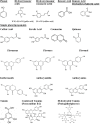Antimicrobial Activity of Polyphenols and Alkaloids in Middle Eastern Plants
- PMID: 31156565
- PMCID: PMC6529554
- DOI: 10.3389/fmicb.2019.00911
Antimicrobial Activity of Polyphenols and Alkaloids in Middle Eastern Plants
Abstract
Antibiotic-resistant microorganisms have been an ever-growing concern over the past years. This has led researchers to direct their attention onto plants to be able to discover new possible antimicrobial compounds. The Middle East encompasses a wide spectrum of plant diversity with over 20,000 different species in habitats ranging from deserts to snow-capped mountains. Several plant secondary metabolites and their derivatives have been identified as possible antimicrobial agents. Among the secondary metabolites studied, alkaloids and polyphenols have shown strong antimicrobial activity. Polyphenols are one of the most numerous and diverse group of secondary metabolites; their antioxidant properties provide the basis for antimicrobial effects. Alkaloids provided the underlying structure for the development of several antibiotics with a diverse range of action. The ability of some plant secondary metabolites to act as resistance-modifying agents is a promising field in mitigating the spread of bacterial resistance.
Keywords: alkaloids; antimicrobial resistance; plant secondary metabolites; polyphenols; resistance-modifying agent.
Figures
References
-
- Abbas M., Saeed F., Anjum F. M., Afzaal M., Tufail T., Bashir M. S., et al. (2017). Natural polyphenols: an overview. Int. J. Food Prop. 20, 1689–1699. 10.1080/10942912.2016.1220393 - DOI
-
- Abdel-Hameed E. S., El-Nahas H. A., Abo-Sedera S. A. (2008). Antischistosomal and antimicrobial activities of some Egyptian plant species. Pharm. Biol. 46, 626–633. 10.1080/13880200802179543 - DOI
-
- Abdel-Massih R., Abdou E., Baydoun E., Daoud Z. (2010). Antibacterial activity of the extracts obtained from Rosmarinus officinalis, Origanum majorana, and Trigonella foenum-graecum on highly drug-resistant Gram negative bacilli. J. Bot. 2010:464087 10.1155/2010/464087 - DOI
-
- AbdElRahman H. F., Skaug N., Francis G. W. (2002). In vitro antimicrobial effects of crude miswak extracts on oral pathogens. Saudi Dent. J. 10, 15–21.
Publication types
LinkOut - more resources
Full Text Sources
Miscellaneous



